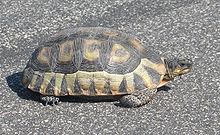African beaked turtle
| African beaked turtle | ||||||||||||
|---|---|---|---|---|---|---|---|---|---|---|---|---|

African beaked turtle |
||||||||||||
| Systematics | ||||||||||||
|
||||||||||||
| Scientific name of the genus | ||||||||||||
| Chersina | ||||||||||||
| JE Gray , 1831 | ||||||||||||
| Scientific name of the species | ||||||||||||
| Chersina angulata | ||||||||||||
| ( Schweigger , 1812) |
The African beak- breasted turtle ( Chersina angulata ) is a species from the tortoise family and the only species that belongs to the genus Chersina . It is native to South Africa and Namibia .
Appearance
Adult males of the African beak-breasted turtle have a carapace of 22.5 to 28.5 centimeters. Females stay significantly smaller and have a carapace length between 18.5 and 22.5 centimeters. The species usually has 10 edge shields. The belly armor is slightly longer than the back armor, which is relatively long and narrow.
The color of the back armor is very variable and ranges from a light horn color to a yellowish-brown to an olive. The individual vertebrae and back shields each have dark edges and a dark center, which clearly stands out from the lighter center of the shield. The edge shields in the front area and in the middle of the body have dark triangles on a light background. The belly armor is yellow to yellow-reddish.
Males can be distinguished from females by the concave belly armor and the longer and thicker tail.
Distribution, habitat and way of life
The African beak-breasted turtle is native to South Africa and Namibia, where it occurs in both semi-deserts and more humid areas. Their habitat is characterized by hot and dry summers and cold and rainy winters. The African beak-breasted turtle lives in three different vegetation zones. One is characterized by heather and grass growth as it is characteristic of the south and west of the Cape region, zones with succulent growth and dune thickets with evergreen trees and bushes.
The African beaked turtle is active all year round. During long rainy and cool winters, however, she also uses self-dug caves. It has a predominantly vegetable diet and also supplements its diet with snails. It also eats the feces of mammals. The clutch of the African beaked turtle usually only contains one egg, in exceptional cases two. The time it takes for a young animal to hatch from the egg depends on the ambient temperature and humidity. As a rule, between 90 and 125 days elapse between egg laying and hatching.
proof
Individual evidence
- ↑ Rogner, p. 82.
literature
- Manfred Rogner: Tortoises - biology, keeping, reproduction. Eugen Ulmer KG, Stuttgart 2008, ISBN 978-3-8001-5440-1 .
